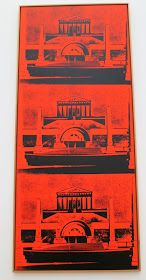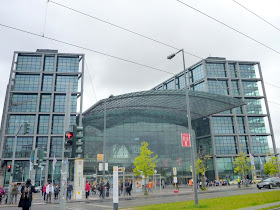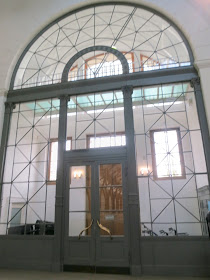Room, at the Mead Gallery,
University of Warwick Arts Centre.
Installations, sculptures and photographs by women artists who explore ideas about architecture and the domestic environment - historically perceived as a female sphere of activity.

Photography is not allowed in the exhibition, but I did manage to take some photographs before I was informed of this. The Francesca Woodman photographs I have reproduced from posts on the artist, which you can find here , here , and here

Sarah Lucas, Chuffing Away to Oblivion, (1996)
Lucas has created a makeshift enclosure for smoking made out of timber, walled with brown paper.
This claustrophobic space is illuminated by a single bare lightbulb and its floor is strewn with discarded cigarette ends. The structure is internally coated with yellowing newspapers which have been glazed with shellac oil to suggest a greasy and nicotine-stained den.
The installation reflects Lucas' long-running fascination with drab social or personal spaces, especially those associated with men and masculinity. Here, the idea of a private male sanctuary is reflected in the salacious - often overtly sexual - contents of the varnish-coated pages gathered from British tabloids. The deliberate flimsiness of the construction might be read as a metaphor for the fragility of constructions of masculinity - the hollowness of bravado - as well as their inescapability. The lock to the enclosure is symbolically located on the outside.
Heidi Bucher, Herrenzimmer, 1977-78
Bucher moulded the interior of her father's study in Winterthur. She first lined the surfaces of the room with fine tulle, and then applied layers of liquid latex in order to coat the surfaces - including the wood panelling, tiled floors and cast iron radiators - with a membranous film. She peeled this away like skin, bearing the imprint of the room's décor and architecture.
The fragmentary panels - resembling expanses of dried parchment or animal hide - hang from the ceiling. The material has yellowed and hardened with age, accentuating the distance between the original room and its insubstantial after-trace.
Marvin Gaye Chetwynd, The Folding House, 2010
This installation was inspired by a visit to the Rietvild Schroeder House in Utrecht, a modernist home built in 1924 by the Dutch architect and pioneer of De Stilj, Gerritt Rietfeld, in collaboration with the owner Truus Schroeder-Schraeder. The Schroeder House uses sliding partitions to break down the division between inside and outside and to create versatile, dynamic spaces.
The Folding House is a free-standing and elevated structure - a bricolage of wooden flats, sections of fabric and recycled windows - which emulates the versatility and formal simplicity of the Rietvild Schroeder House. Two hinged 'doors' on one side of the structure can be opened to reveal its interior; while its assorted walls, windows and empty 'apertures' deconstruct the division between interior and exterior space.
Louise Bourgeois, Cell XVIII, (Portrait), 2000
Francesca Woodman:
I am including three out of the 12 photographs in the exhibition.
The settings of Woodman's images are blanched and ragged - evocatively nondescript settings in which light and space are as powerful as material forms, and where the body is a metamorphic, occasionally invisible subject. A number of the works exemplify her use of slow exposure, allowing her subjects to move - and thereby to blur or disappear.





















































